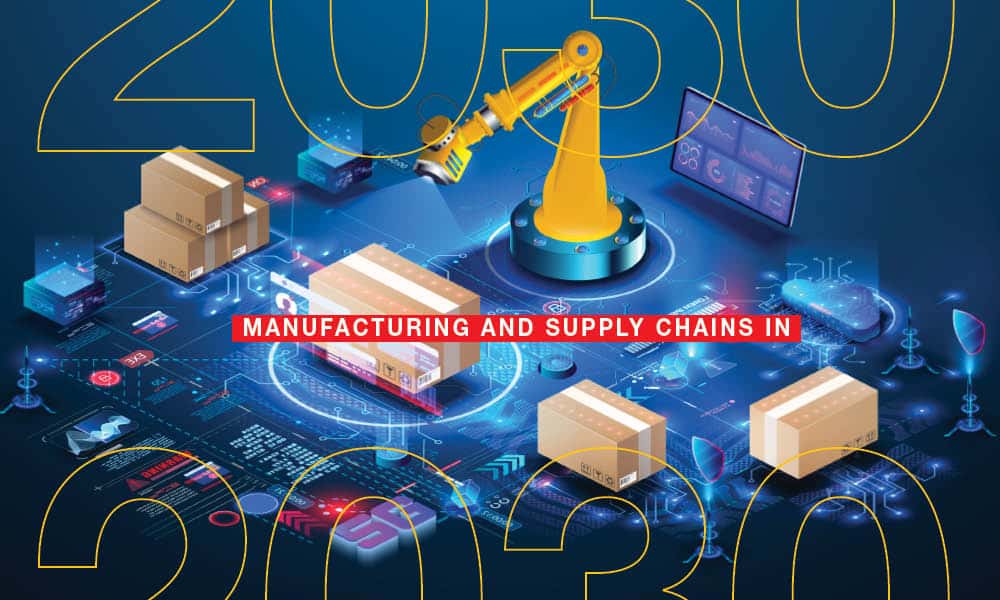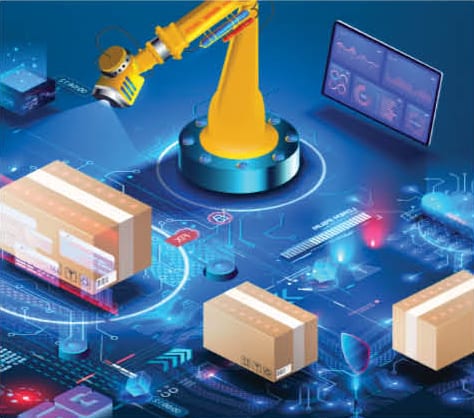Manufacturing and Supply Chains in 2030

AI, digitalization, automation, and proximity to end markets will shape supply chains over the next decade.

TAKEAWAYS:
● Creating flexible, resilient supply chains brings increased inventory, more suppliers, and higher input costs.
● With AI, companies can ideate, create prototypes, improve processes, and analyze problems rapidly.
● To be competitive, businesses will need to invest in AI, digitalization, and automation.
Manufacturers have made significant changes over the last three years as global events exposed structural vulnerabilities in just-in-time shipping and supply chain operations. Now, disruptive artificial intelligence (AI) technologies signal that another market transformation may be upon us alongside those other forces reshaping supply chains.
Over the next decade, companies will continue to prioritize flexible, resilient supply chains. But that flexibility brings a higher cost in the form of increased inventory, more suppliers, and higher input costs. In 2030, we expect AI will play a larger role in helping manufacturers manage supply chain costs strategically. Proximity to end markets and the increased presence of digitalization and automation will also shape supply chains. Global middle market manufacturers will need to invest in their supply chain capabilities with these factors in mind.
AI in Manufacturing
AI will be both disruptive and enabling. AI is neither an unthinkable nor unexpected external market force—its impact will only increase over time. Manufacturers should view AI as an enabler that can improve their business.
According to a recent MIT Technology Review article, the most likely use cases for AI in the industrial space will be software developed for logistics, transportation, civil engineering, construction, energy, and manufacturing. Manufacturers should consider dedicating research and development (R&D) and innovation teams to monitor when software-as-a-service companies incorporate AI into new and existing software and when those technologies are expected to hit the market.
Because AI solutions will largely come in the form of software, companies’ software expenditures—already on a steep incline in recent years—will continue to grow (Figure 1). But AI will also help industrial businesses rapidly ideate, create prototypes, make process improvements, and analyze narrowly defined problems, all of which will help mitigate costs.
Figure 1: U.S. Software Expenditures*

ChatGPT, for example, represents a significant leap in AI capabilities and provides a helpful glimpse of what is possible. The AI tool—classified as generative AI—was released in November 2022. Its output, though imperfect, will get exponentially better in the next few years, as will that of other AI tools such as Claude AI.
Hurdles do remain for widespread AI adoption though. For AI to work well and to be effective, it needs good training data. Raw data will not produce good results on their own; a human must clean and transform large volumes of that information into usable data sets. To address this issue, we anticipate software companies creating synthetic training data representing a problem that an AI model seeks to solve, resulting in a significant improvement in adoption rates.

“By 2030, 60 percent of manufacturers expect more nearshoring or onshoring of their operations to boost resiliency and better meet local customer needs.”
Implementing AI for its own sake will not be beneficial for manufacturers. Any AI project should have a clear path to profitability and pay for itself in efficiencies. A rule of thumb is to start small and aim to scale up later.
Proximity to End Markets
Manufacturers still need to think holistically about how they incorporate AI alongside other changes, such as moving operations closer to their end markets. Recent Manufacturing Leadership Council surveys found that by 2030, 60 percent of manufacturers expect more nearshoring or onshoring of their operations to boost resiliency and better meet local customer needs. Indeed, U.S. foreign direct investment to and from key geographies such as China is showing signs of shifting as geopolitical tensions steer manufacturing away from that country.
In 2021, China saw a 6 percent drop in foreign direct investment (FDI) from the U.S., according to U.S. Bureau of Economic Analysis data. In 2021, India saw U.S. FDI increase by 7.6 percent (Figure 2). During 2020 and 2021, Mexico saw a 9.1 percent and 6.1 percent increase in FDI from the U.S., respectively. Both countries are positioning themselves as friendly alternatives to China.
Figure 2: U.S. Foreign Direct Investment in India*

Figure 3: U.S. Foreign Direct Investment in Mexico*

As 2030 approaches, we anticipate this shift toward nearshoring will accelerate. Companies that are eyeing factories in new locations should assess where there may be simultaneous opportunities to invest in digitalization and automation at those facilities.
Digitalization in Manufacturing
Digitalization will continue to be the driving force behind evolution for manufacturers across their business functions; 83.9 percent of executives surveyed by the Manufacturing Leadership Council expect digital adoption will accelerate in manufacturing throughout the decade. Ninety-one percent of those surveyed agree they will need to spend more on digitalizing their businesses than they currently do. Factors contributing to this trend include baby boomers retiring, lack of access to skilled and unskilled labor, and the need to increase operational productivity and capacity.
Digitalized factories provide automated real-time alerts and analytics for production, and for shop floor and warehouse performance, all of which can help manufacturers pivot in the face of those workforce challenges. Data analytics that feed dashboards with set key performance indicators can enable management to be more flexible. E-learning and learning management systems can help with onboarding, training, and retaining new staff.
Looking Ahead
The complex nature of developing a supply chain fit for 2030 will take time, patience, and thoughtful investment in talent, new business infrastructure, and key business processes. Manufacturers should start assessing which changes they need to make now. M
This article is adapted from the original version published on RSMUS.com in April 2023. It has been modified with RSM’s consent.
About the author:

Matt Dollard is an industrials senior analyst at RSM US LLP.